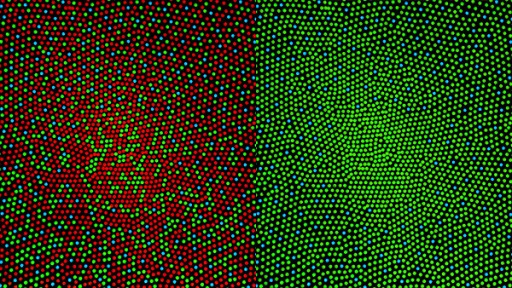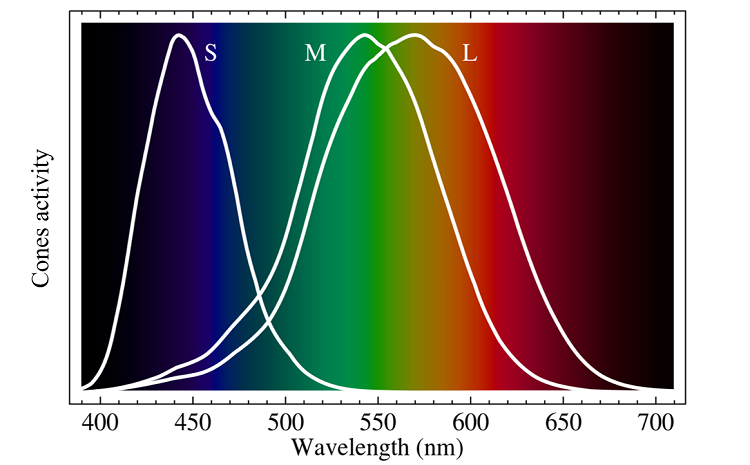This post is also available in Dutch.
It is no coincidence that warning and informative signs are always red or green. The reason is that most humans better see red and green colors. However, for 6% of men and less than 1% of women it is more challenging to distinguish these two colors…
Light is made of electromagnetic radiations of different wavelengths that we perceive as colors. All visual information is first received by the retina, the membrane that lines the eye and whose function is to transmit visual information to the brain. Of the many types of cells the retina contains, cones specifically are involved in color perception. S cones show a peak of activity for short wavelengths (which we perceive as the color blue), whereas M and L cones are maximally sensitive to medium and long wavelengths (which we perceive as green and red, respectively). The level of activity for each type of cone depends on the perceived wavelength across the continuous spectrum of light (see the image below). Moreover, there is no one-to-one correspondence between a type of cone and a color as the measure of activity of a cone is not binary (ON/OFF).
The main reason why red and green colors are more strongly detected than blue is due to the fact that a higher number of cones are simultaneously activated (both M and L types) when perceiving it. Due to this overlap, you can’t perceive something as being both red and green because the two colors activate the same cones, but in a different manner.
Look at this field of flowers, for example. While for most people it is very easy to distinguish the red from the green (poppy petal vs. stalk), it is harder to tell apart the blue from the green (blue petal vs stalk).
What is happening is that when a given point in space is perceived as green, both M and L cones are no longer available to detect red at this specific location. What is enabling us to determine if it is red or green depends on how these cones are activated (red activates L cones more than M, and vice versa for green). Therefore, the perception and distinction of red and green gets enhanced.
R&G color vision in non-human primates
During evolution, primates have shown different capacities in distinguishing colors in the red-green spectrum of light. In Old World primate communities, it is believed that the sensitivity to red and green colors conferred several selective advantages in finding food, detecting predators and perceiving socio-sexual signs. In comparison, many New World primates, and most mammals in general, only show two types of cones, responding to short or long wavelengths, preventing them from distinguishing red from green. This apparent limitation in color vision might actually present other advantages such as spotting camouflaged animals and insects. These two examples show how important it is to have a color vision system adapted to one’s environment.
R&G color vision in humans
While most humans are able to discriminate between red and green, about 6% of men and 0.5% of women have red-green blindness which prevents them from making a clear distinction between these colors. This visual alteration is caused by a genetic mutation affecting the M or L cones in the retina. Unfortunately, as opposed to monkeys, red-green blindness is particularly associated with disadvantages in our visual environment. Indeed, you surely have noticed how most of relevant visual information is marked in red and green around us: traffic signals along the road, special discounts at the supermarket, schoolwork corrections, etc. The question is particularly concerning in the field of road safety as it has been shown that red-green blind people need more time to react to warning signs. However, recently a visual rehabilitation method consisting in temporarily wearing glasses with lenses that enhance colors contrast has showed promising results.
Is the Red-Green code for everyone?
Our environment is full of color codes with specific meanings. Therefore, being able to distinguish between colors determines how we experience the world. We have seen that, most people are particularly good at distinguishing between red and green. However, this ability is also directly impaired in red-green blindness, the most common form of color blindness (followed by the blue-yellow and the total color blindness). Thus, it should be questioned whether the choice of red and green as a universal color code to draw people’s attention to any specific danger or important information is optimal.
Photo by PIXNIO and Wikipedia
Author: Kim Beneyton
Buddy: Christina Isakoglou
Editor: Monica Wagner
Translator: Ellen Lommerse
Editor Translation: Wessel Hieselaar


